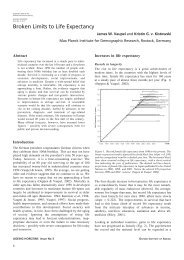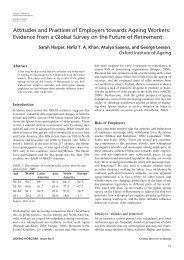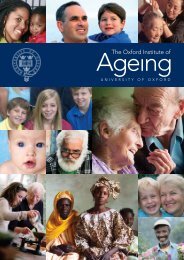Upskilling Older Workers by Ken Mayhew, Matt Elliott, and Bob Rijkers
Upskilling Older Workers by Ken Mayhew, Matt Elliott, and Bob Rijkers
Upskilling Older Workers by Ken Mayhew, Matt Elliott, and Bob Rijkers
You also want an ePaper? Increase the reach of your titles
YUMPU automatically turns print PDFs into web optimized ePapers that Google loves.
Notes<br />
1 Denmark, Irel<strong>and</strong>, Portugal, Finl<strong>and</strong>, Sweden, the UK.<br />
2 France, Germany, Greece, Netherl<strong>and</strong>s, Spain.<br />
3 Belgium, Italy, Luxemburg, Austria.<br />
4 Calculated from participation <strong>and</strong> unemployment rates.<br />
5 Annual Survey of Hours <strong>and</strong> Earnings.<br />
6 European Commission (2003, p.174) reports that “the<br />
productivity of older workers is not impaired <strong>by</strong> age but <strong>by</strong> skill<br />
obsolescence”.<br />
7 For example, older workers’ may be less willing to learning new<br />
skills. Hausman (2003) finds that older workers attitudes <strong>and</strong><br />
motivation are very important for their employment prospects.<br />
8 They use a regression methodology <strong>and</strong> control for unionisation,<br />
percentage of jobs that are in the public sector, percentage of employees<br />
that are male <strong>and</strong> the percentage of employees that are permanent.<br />
Similar results are obtained for the flow of older workers<br />
9 TSER Report (2000), table 3.<br />
10 See for example OECD country reports on the UK (OECD<br />
2005b), Luxembourg (OECD, 2004h) <strong>and</strong> Italy (OECD, 2004g)<br />
as well as MORI (2002), <strong>and</strong> DTI (2004).<br />
11 Professor Dominic Abrams of the University of <strong>Ken</strong>t <strong>and</strong> Sujata<br />
Ray, Research Adviser at ACE, presented findings from this<br />
Survey in 2006: Tackling Age Discrimination, Beyond the<br />
Workplace, Age Concern Seminar Series, July 2006.<br />
12 Aigner <strong>and</strong> Cain show that discrimination can persist due to a<br />
positive feedback mechanism with no productivity difference<br />
between two groups of workers. The two groups, in our case<br />
older <strong>and</strong> younger workers, are assumed to have the same<br />
average ability <strong>and</strong> the same variance in ability. However, ability<br />
is more precisely observed for younger workers than older<br />
workers. A risk adverse employer will then be more inclined to<br />
employ a younger worker than an older worker with the same<br />
expected ability, because the ability of the older worker is more<br />
uncertain. This will result in employment of more younger<br />
workers than older workers <strong>and</strong> might be self enforcing if<br />
employing more younger workers helps an employer to better<br />
estimate the ability of other younger workers.<br />
13 Another way in which older workers may have been discouraged to<br />
participate in the labour market is though the disability benefits<br />
offered <strong>by</strong> governments. For example, Faggio <strong>and</strong> Nickell (2003)<br />
argue that doctors in the UK may have colluded with older patients<br />
to let them take up disability benefits which reduced the incentives<br />
for older workers to remain in employment. There is also evidence<br />
for this occurring in the Netherl<strong>and</strong>s.<br />
14 Gibbons <strong>and</strong> Murphy (1992) provide evidence that explicit incentive<br />
contracts are stronger towards the end of workers’ careers. Such a<br />
response is shown to be theoretically optimal in the presence of<br />
declining implicit incentives for older workers to exert effort.<br />
15 This explanation also has serious policy implications since it could<br />
imply that training interventions for particular groups would have<br />
no effect on the jobs available in the queue as a whole, <strong>and</strong> at best<br />
would improve the position of the target group, at the expense of<br />
some other group, without any overall Pareto improvement. There<br />
is some limited empirical support for this proposition. Work on<br />
crowding-out <strong>by</strong> Teulings <strong>and</strong> Koopmanschap (1989) <strong>and</strong>, to a<br />
lesser extent, Van Ours <strong>and</strong> Ridder (1995) support this hypothesis<br />
although the findings of Gautier et al (2002) are inconsistent with<br />
crowding-out. The OECD (2004) finds no effect of training on the<br />
aggregate level, whereas it does find that training improves<br />
prospects on the individual level, which is entirely consistent with<br />
a job queuing explanation.<br />
16 As shown above, older workers as a whole might be expected to<br />
have lower skill endowments than other workers.<br />
17 For example, the exact quality of workers is often unobserved.<br />
Thus the difference in quality between workers could explain<br />
much of the variation in wages. If workers of unobserved higher<br />
quality use more new technology, then their higher wages will be<br />
attributed to the technological difference, when it is actually<br />
being driven <strong>by</strong> observed differences in quality between workers.<br />
References<br />
Aigner, D.J. <strong>and</strong> G. Cain (1977) Statistical Theories of<br />
Discrimination in Labor Markets. Industrial <strong>and</strong> Labor Relations<br />
Review, 30(2), pp. 175–187.<br />
Allen, J. <strong>and</strong> R. van der Velden (2002) When Do Skills Become<br />
Obsolete <strong>and</strong> When Does it <strong>Matt</strong>er? In: De Grip, A., J. van Loo<br />
<strong>and</strong> K. <strong>Mayhew</strong> (eds.) The Economics of Skills Obsolescence:<br />
Theoretical Innovations <strong>and</strong> Empirical Applications. Research in<br />
Labor Economics 21, JAI.<br />
Arrow, K.J. (1973) The Theory of Discrimination, in<br />
Discrimination in Labor Markets, edited <strong>by</strong> Ashenfelter, O. <strong>and</strong><br />
A. Rees. Princeton: Princeton University Press.<br />
Atkinson, J. <strong>and</strong> S. Dewson (2001) Evaluation of New Deal 50<br />
Plus: Research with Individuals (Wave 1), Employment Service<br />
Research Report ESR 91.<br />
Aubert, P., E. Caroli, <strong>and</strong> M. Roger (2004) New Technologies,<br />
Workplace Organisation <strong>and</strong> the Age Structure of the<br />
Workforce: Firm–level Evidence, CREST–INSEE <strong>and</strong> INRA–LEA<br />
Working Paper.<br />
Ballot, G., F. Fakhkakh <strong>and</strong> E. Taymaz (2001) Who Benefits from<br />
Training <strong>and</strong> R&D? The Firm or the <strong>Workers</strong>? A Study on<br />
Panels of French <strong>and</strong> Swedish Firms, ERMES Working Paper No<br />
01–12.<br />
Bartel, A. <strong>and</strong> N. Sicherman (1993) Technological Change <strong>and</strong><br />
Retirement Decisions of <strong>Older</strong> <strong>Workers</strong>. Journal of Labor<br />
Economics, 11.<br />
Blundell, R. (2000) Comments on James Heckman’s ‘Policies to<br />
Foster Human Capital’. Research in Economics, 54.<br />
Borghans, L, <strong>and</strong> B. ter Weel (2002) Do <strong>Older</strong> <strong>Workers</strong> Have<br />
More Trouble Using A Computer than Younger <strong>Workers</strong>. In: De<br />
Grip, A., J. van Loo <strong>and</strong> K. <strong>Mayhew</strong> (eds.) The Economics of<br />
Skills Obsolescence: Theoretical Innovations <strong>and</strong> Empirical<br />
Applications. Research in Labor Economics 21, JAI.<br />
Cabinet Office (2000) Winning the Generation Game: Improving<br />
Opportunities for People Aged 50–65 in Work <strong>and</strong> Community<br />
Activity, Performance <strong>and</strong> Innovation Unit Report. Available<br />
online at: http://www.number-10.gov.uk/su/winning/active/.<br />
Cabinet Office (2004) Personal Responsibility <strong>and</strong> Changing<br />
Behaviour: The State of Knowledge <strong>and</strong> its Implications for<br />
Public Policy (Issue Paper for Discussion Purposes), London.<br />
Centre for Research into the <strong>Older</strong> Workforce (CROW) (2004) Are<br />
<strong>Older</strong> <strong>Workers</strong> Different?, CROW Briefing Paper 1.<br />
de Grip, D. <strong>and</strong> J. van Loo (2002) The Economics of Skills<br />
Obsolescence: A Review. In: de Grip, A., van Loo, J. <strong>and</strong><br />
<strong>Mayhew</strong>, K. (eds.) The Economics of Skills Obsolescence:<br />
Theoretical Innovations <strong>and</strong> Empirical Applications. Research in<br />
Labor Economics 21, JAI.<br />
Dearden, L., H. Reed, <strong>and</strong> J. van Reenen (2000) Who Gains<br />
When <strong>Workers</strong> Train? Training <strong>and</strong> Corporate Productivity in a<br />
Panel of British Industries, IFS Working Paper WP 00/04.<br />
Department of Trade <strong>and</strong> Industry (2004) Partial Regulatory Impact<br />
Assessment for Age Discrimination Legislation. Available online<br />
at: http://www.dti.gov.uk/er/equality/agedisrim_RIA.pdf.<br />
Dickerson, A. <strong>and</strong> F. Green (2002) The Growth <strong>and</strong> Valuation of<br />
Basic Skills, SKOPE Research Paper No. 26.<br />
Disney, R., <strong>and</strong> D. Hawkes (2003) Why has Employment Recently<br />
Risen among <strong>Older</strong> <strong>Workers</strong> in Britain? Available online at:<br />
http://www.nottingham.ac.uk/economics/staff/details/papers/Disn<br />
ey-Hawkes-Chapter4.pdf.<br />
Disney, R., <strong>and</strong> Hawkes, D. Declining job opportunities for older<br />
workers in Britain: the role of job specific characteristics (under<br />
revision).<br />
European Commission (2003) Employment in Europe 2003,<br />
Luxembourg: Office for Official Publications of the European<br />
Communities.<br />
AGEING HORIZONS Issue No 8<br />
OXFORD INSTITUTE OF AGEING<br />
20





![ORAL PRESENTATIONS [pdf] - Oxford Institute of Ageing](https://img.yumpu.com/37918222/1/184x260/oral-presentations-pdf-oxford-institute-of-ageing.jpg?quality=85)




